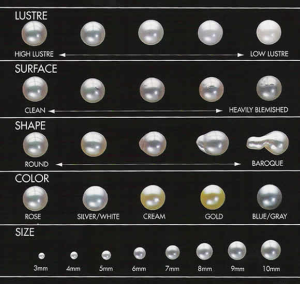Pearls Plus One of Chicago, IL specializes in teaching their customers how unique their grade cultured pearl jewelry is. For over 30 years, we have provided one-on-one service to all of our customers to explain each treasure they are purchasing, or already own. A strand of pearls can be customized to match each customer – because each pearl is as individual as the person wearing them.
How Pearls are Grown:
Pearls are organic gems formed inside mollusks such as oysters and mussels when an irritant (such as some sand) gets into the mollusk’s shell. In defense, the mollusk coats the object with layers of nacre forming the pearl. The iridescent luster occurs from light reflecting and refracting on the overlapping layers in a process that can take up to seven or eight years. Pearls vary in color from white to pink, brown or black and the coloration depends on the type of mollusk and its habitat.
Difference Between Cultured and Natural Pearls:
Cultured pearls are pearls that form over time but are assisted by man. They can be genuine so long as they are grown inside of living mollusks in oceans and lakes. With cultured pearls, man assists the formation of the pearl by inserting an irritant (a surgically implanted bead, piece of shell or mollusk tissue) to initiate the secretion of nacre by the mollusk. There are various colors and shapes available with cultured pearls and they come from a variety of locations.
Determining a Pearl’s Value:
When buying pearls, consider origin, size, shape, nacre thickness, color, luster, surface clarity and matching. Each category has different weight in the value of the pearl with luster being the most important quality. Luster refers to the reflection and refraction of light passing through the layers of nacre. The intensity of the manipulation of light is determined by the geometric pattern secreted nacre forms as well as nacre thickness and the mollusk’s habitat. Surface quality is determined by the presence of physical blemishes or flaws. Pearls vary in shape from round to semi-round, from off-round to oval, and from drop to baroque with round to drop being pretty symmetrical. Color is informed by the wearer’s presence, and cultured pearls come in a variety of colors from rose` to black. Lastly, matching refers to the uniformity of color, luster, shape, spotting and graduation.

Difference Between “AA” and “AAA” Quality Pearls:
While there is no industry-wide standard of grading at this time, there are two major systems, the AAA-A system and the Tahitian system. In the AAA-A system, AAA Quality pearls are the highest graded pearls in comparison to AA and are of course, more expensive. Some of the important factors that affect a pearl’s grade are the pearl’s luster, shape, flaws/blemishes and its matching quality. AA Quality pearls, having good luster and a clean surface, are more cost effective and are requested more often.
Visit the Cultured Pearl Association for more complete information about pearls.
Contact Pearls Plus One today at 708-354-8500 to speak with a fine jewelry expert, or browse our website for more information about our products or pearl photo gallery.